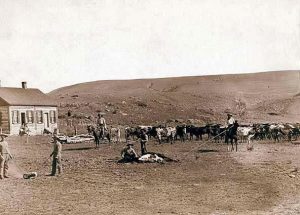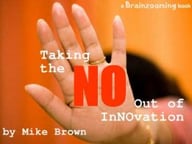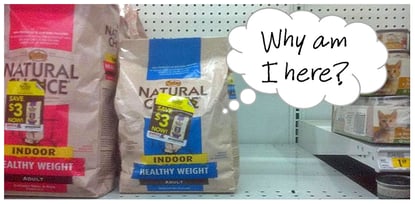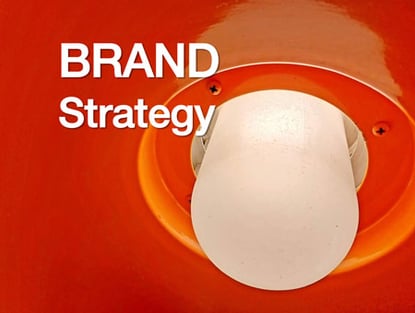B2B marketing expert Randall Rozin (who you can find on Twitter under his @RandallRozin account) is back with a history lesson on branding in the Wild West and how that models translate to the important area of employee branding in today's companies.
Employee Branding Lessons - Riding for the Brand by Randall Rozin
 In the late 1800s, brands were like a heraldic crest, a cattleman’s coat of arms, if you will. Brands identified not only an owner or a ranch; they also provided a set of traditions and a unique sense of identity for the cowboys who represented the brand’s ranch. It was not uncommon for a cowboy of the times to ride for the brand more than for the individual ranch owner.
In the late 1800s, brands were like a heraldic crest, a cattleman’s coat of arms, if you will. Brands identified not only an owner or a ranch; they also provided a set of traditions and a unique sense of identity for the cowboys who represented the brand’s ranch. It was not uncommon for a cowboy of the times to ride for the brand more than for the individual ranch owner.
As the preface to his short story of the same name, Louis L’Amour described the term ‘riding for the brand’ as an expression of loyalty to an employer. It was considered a compliment of the highest order. Today, a great deal of effort is invested by companies creating internal branding efforts designed to inspire employee identity, loyalty, and a sense of ‘riding for the brand’.
Background on the Cowboy Branding Process
 On the great plains of the American West, Ketch Hands roped each calf and pulled it near the branding fire. Flankers then grabbed the calf by the ear and loose skin of the flank, lifted it up and laid it on its side. Others called out the brand of the calf’s mother and the appropriate branding iron was brought to the fire. While one man held the calf, an Iron Man branded the calf at the hips, ribs, or shoulder according to the practice of the owner.
On the great plains of the American West, Ketch Hands roped each calf and pulled it near the branding fire. Flankers then grabbed the calf by the ear and loose skin of the flank, lifted it up and laid it on its side. Others called out the brand of the calf’s mother and the appropriate branding iron was brought to the fire. While one man held the calf, an Iron Man branded the calf at the hips, ribs, or shoulder according to the practice of the owner.
From Cowboys to Corporations
Modern corporate brand managers employ an analogous branding process. Today’s “Ketch Hands” are typical pre-purchase activities such as advertising, sales promotions, point of-purchase displays, permission-based marketing, social media, and trade show sellers. Each element is designed to bring potential buyers “closer to the branding fire.”
Ropers of today often take the form of marketing automation and other CRM processes. As prospects come into the company via electronic means they are tagged via a cookie or other ad-serving technique to identify their origin. Some companies have consistently done their branding job so well that their customers come willingly to the “branding fire.” Examples where customers actually brand themselves include: Harley Davidson Motorcycles (whose customers often tattoo the company’s logo on their bodies) or many apparel brand fans such as those of Nike –whose millions of customers around the world brand themselves with the Nike Swoosh.
Employee Branding - Supporting Your Brand "Iron Men and Women"
Where the ultimate aim is for customers to perceive a brand as unique, relevant, credible, and differentiated enough to seek it out, most brand managers must adopt the cowboy’s “iron man” process and apply the brand one interaction at a time. However, rather than having one “iron man,” modern brand managers must look for ways to make each brand representative an “iron man” in their own right. Today’s brand “iron men and women” must look for ways to imprint their brand on their customers through employee branding behaviors, attitudes, and consistent delivery of brand promises made at all points of contact.
Likewise for employee branding efforts, today’s management teams and leadership must continuously find credible ways to apply their own branding iron to their employees. They do this by creating consistent linkage between company values, goals, and behaviors. They link reward and recognition systems to the delivery of company brand behaviors and create compelling workplaces that consistently live the brand they advocate. It’s no simple task to authentically and consistently connect brand aspirations to brand behaviors, but walking the walk in visible ways is a best place to start.
While it is entertaining to draw similarities between the branding process of cowboys and the modern branding of corporations it is, admittedly, an over simplification. Today’s brand managers do not have the luxury of taking one key opportunity to permanently brand their customers for life. In addition, unlike the rancher, the brand is not truly owned by the company, but by the customer.
Create More Riders for the Brand
An important goal of the modern brand manager is to uncover each “moment of truth” in the relationship between his/her brand and the customer. It is equally important to define for employees the role they play in delivering against a given "moment of truth." It is within each moment of truth that brands are truly built or damaged. The key for effective overall brand management is to ensure that each “iron man” understands his or her role in the branding process.
Like the cowboys of the Wild West, today’s brand manager looks for ways to differentiate his/her product or service from similar offerings. The modern brand is a sign of ownership, of heritage, of quality level, and of employee identification and affiliation. The ultimate goal of both the cowboys of the past, and brand managers of today, is to create more ‘riders for the brand’ to help differentiate the brand and to create more loyal advocates for it. – Randall Rozin
If you enjoyed this article, subscribe to the free Brainzooming blog email updates.
Download the free ebook, “Taking the NO Out of InNOvation” to help you generate fantastic creative thinking and ideas! For an organizational innovation success boost, contact The Brainzooming Group to help your team be more successful by rapidly expanding strategic options and creating innovative plans to efficiently implement. Email us at info@brainzooming.com or call us at 816-509-5320 to learn how we can deliver these benefits for you.




